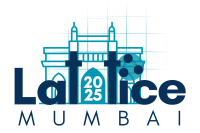Speaker
Description
The calculation of the hadronic form factors on the lattice provides important information about the internal structure of the corresponding states. However, calculating the form factor for unstable states, viz. resonances, is not as straightforward, both from the conceptual point of view and in terms of technical implementation. In this work, we specifically consider the electromagnetic form factor of the $\rho$-meson. It is well known that the matrix element of the current between two eigenstates of the lattice Hamiltonian with energies close to the resonance mass does not possess a well-defined infinite-volume limit, even if the Lellouch-Lüscher factors for the external legs are properly taken into account. The reason for this is that the triangle diagram, where the external current is hooked on to one of the constituents of the resonance, does not exhibit a regular dependence on the box size.
In this work, we make use of the external field method (the Feynman-Hellmann method), where the system is placed in an external field, coupling to a spatially periodic current. The structure of the finite-volume energy levels is described by the modified Lüscher equation, which enables one to directly extract the short-range part of the interaction with the external field from the fit to the shifted energy levels. This method has the advantage that the separation of the triangle diagram is automatically taken into account, and the short-range interaction has a regular dependence on L, which is exponentially suppressed for large L. Through this work, we provide complete framework for the extraction of the form factor from raw lattice data, when available. We, in addition, provide a crude estimate of the short-range contribution to the form factor at the lowest order in ChPT.
| Parallel Session (for talks only) | Structure of hadrons and nuclei |
|---|

